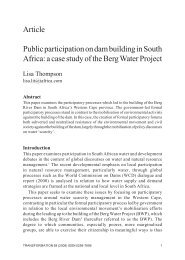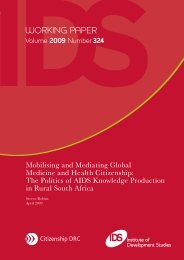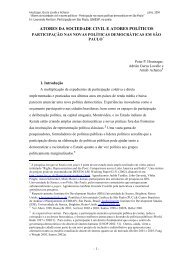Associations and the Exercise of Democratic ... - Citizenship DRC
Associations and the Exercise of Democratic ... - Citizenship DRC
Associations and the Exercise of Democratic ... - Citizenship DRC
You also want an ePaper? Increase the reach of your titles
YUMPU automatically turns print PDFs into web optimized ePapers that Google loves.
IDS WORKING PAPER 285We observe above that labour market insertion shapes <strong>the</strong> likelihood <strong>of</strong> citizens tobecome active in different ways in <strong>the</strong> two cities. In São Paulo people who are in<strong>the</strong> labour market, whe<strong>the</strong>r employed or not, are active at a far higher rate thanthose who are outside. From our sample we can predict that 41.8 per cent <strong>of</strong> <strong>the</strong>people in <strong>the</strong> labour market will be active, whereas only 25.8 per cent <strong>of</strong> thoseoutside <strong>of</strong> <strong>the</strong> labour market will. This discrepancy also exists for mobilisinggovernment <strong>and</strong> direct civil relations. In Mexico City, we find that people withcertain types <strong>of</strong> employment are active to different degrees. Individuals with <strong>the</strong>irown businesses are more active than people with formal or informal employmentrelations. This citizenship activity appears to occur largely through detached relations,as <strong>the</strong> proclivity <strong>of</strong> individuals with <strong>the</strong>ir own business to be active drops significantlyfor <strong>the</strong> variable mobilising government.5.3 Do associations reduce <strong>the</strong> socio-economic stratification <strong>of</strong>citizenship?The preceding analysis shows that socio-economic forms <strong>of</strong> stratification have asubstantial impact on citizens’ civil relations to government. This is particularlymarked in São Paulo, where almost a fifth <strong>of</strong> <strong>the</strong> population – that with littleeducation <strong>and</strong>/or outside <strong>of</strong> <strong>the</strong> labour market – has no civil relations <strong>of</strong> any type.Do associations reduce this form <strong>of</strong> stratification <strong>of</strong> citizen-government relations?The answer to this question involves <strong>the</strong> interaction <strong>of</strong> two distinct components.One is <strong>the</strong> extent to which <strong>the</strong> associational effect on active citizenship for peoplewho occupy lower positions are greater than those for people who occupy higherpositions. The second is <strong>the</strong> share <strong>of</strong> people in lower positions that participate inassociations <strong>and</strong> hence obtain this potentially ‘greater’ effect. The overall effect onreducing <strong>the</strong> gap in active citizenship <strong>the</strong>refore depends in part on how severelyassociational participation is itself stratified.In <strong>the</strong> preceding analysis we found that in both cities people who participate aremore likely to be active citizens than o<strong>the</strong>rs with similar socio-economiccharacteristics but who lack such participation. Tables 5.3 <strong>and</strong> 5.4 show that peoplewho have less education or have more vulnerable labour market positions acquirefar greater increases in active citizenship from <strong>the</strong>ir participation in associationsthan those better positioned. This effect is far stronger in São Paulo than in MexicoCity. 43 In São Paulo, <strong>the</strong> interactive variables in Table 5.3 show that individuals withassociational participation <strong>and</strong> only primary education or less are considerably morelikely to be active citizens than <strong>the</strong>ir educational peers in general, with averagepropensities <strong>of</strong> 50.6 per cent <strong>and</strong> only 20.1 per cent. The group with highereducation sees only a small increase with associational participation, from 53.5 percent to 59.2 per cent. This difference in <strong>the</strong> strength <strong>of</strong> <strong>the</strong> associational effect is43 The decline in <strong>the</strong> gap to be active in São Paulo falls from 33 per cent points to 9 per cent.In Mexico City <strong>the</strong> gap falls from about 20 per cent points between <strong>the</strong> low <strong>and</strong> higheducation in <strong>the</strong> general population, to 9 per cent once we consider only those with anassociational life. The differences in <strong>the</strong> definition <strong>of</strong> <strong>the</strong> independent variables are not <strong>the</strong>primary source <strong>of</strong> this difference between <strong>the</strong> cities.36





